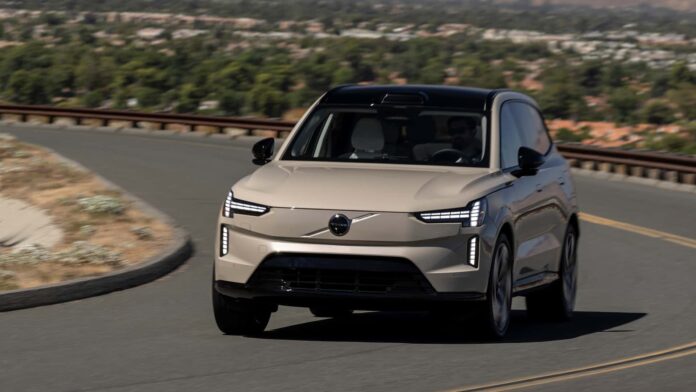
- Volvo will upgrade the EX90’s battery pack.
- In a coming model refresh, the 400V battery will be replaced by an 800V pack.
- This should enable shorter charging stops at DC fast chargers.
Despite its flagship status in Volvo’s lineup of electric models, the EX90 SUV’s high-voltage battery pack is not what I’d call top-tier. That’s because it’s rated at roughly 400 volts, which is fine for most applications, but for a flagship product, it’s behind rivals such as the Kia EV9, Hyundai Ioniq 9 and Lucid Gravity, all of which run at 800V or higher.
Even the Volvo ES90, the recently revealed electric sedan that rides on the same SPA2 architecture as the EX90, will feature an 800V battery pack. So something has to give.
The biggest benefit of an 800V system over a 400V one is its ability to charge at faster speeds. You don’t get more range, but because the number of kilowatts dispensed by a DC fast charger is a simple volts-times-amps math problem, the higher the volts and amps, the higher the kilowatt input.
Volvo knows this, so it will upgrade the EX90’s battery pack to an 800V setup sooner rather than later. Speaking with AutoExpress, Volvo Cars CEO Jim Rowan said: “We started off with 400 volts on the SPA2 architecture, and then we wanted to upgrade that–partly because of range and faster charging speeds; now we can put about 300 kilometers (186 miles) of range on in 10 minutes.”
“As we go forward, we’ll move everything to 800 volts–we’ll upgrade the EX90 in one of the model-year changes,” Rowan added. “And of course, the ES90 starts at 800 [volts], and the EX60 on SPA3 will come out on 800 [volts] as well. That helps us standardize across the platform.”
154
Bear in mind that the EX90 is just hitting dealerships across the world, so the battery change is likely to happen sometime in the next three to four years when the EV is set for a mid-cycle refresh.
Currently, the 400V EX90 can charge at up to 250 kW from a DC fast charger, leading to a 10-80% top-up in as little as 30 minutes. Switching to 800V could slash the charging time by as much as ten minutes when connected to a 350 kW fast charger–a 50% improvement.
All this being said, it’s unclear if Volvo will use the ES90’s 106-kilowatt-hour battery pack in the EX90 when the time comes. Currently, the electric SUV has a 111 kWh pack, but it uses the same architecture as the sedan, albeit with a slightly shorter wheelbase. If Volvo goes down this route–of reusing the ES90’s battery in the EX90–the driving experience should remain largely unchanged. A difference of 5 kWh in capacity could reduce the overall range by a few miles from the current EPA rating of 310 miles, but thanks to faster charging times, it should be a non-issue in the long run.


